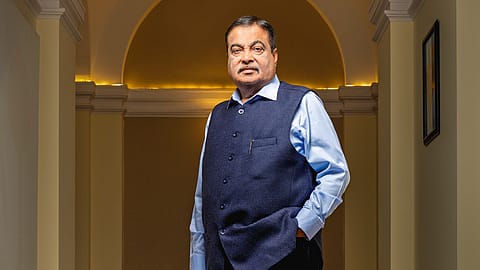‘The picture of India’s roads will change in two years’: Union Minister Nitin Gadkari's ambitious vision for India’s infra growth
Talking exclusively to Fortune India, Nitin Gadkari, the Union Road Transport and Highways Minister, reveals his vision for India's infrastructure growth. He also explains why he remains bullish on India's automobiles industry.

This story belongs to the Fortune India Magazine May 2025 issue.
Where do you see India’s transport sector in the next five years?
The automobile sector is growing at a fast pace. Around 50% of two-wheelers manufactured by domestic companies are getting exported. Our auto industry has risen to the third rank globally from seventh. We have left Japan behind. We will become competitive in electric and hydrogen buses. Our green highways are just the tip of the iceberg. With electric and hydrogen-based mobility, my target is that in the next five years, we should reach the No. 1 position globally.
Highways construction, too, has grown in tandem. What lies ahead?
In the next two years, the picture of the Indian roads will change. The Delhi-Dehradun expressway will be complete in six months and will reduce the commute time to two hours. Delhi-Mumbai, which used to take 50 hours, can be done in 12 hours. Bengaluru to Chennai will take two hours, against the current nine hours. Meerut-Delhi has been reduced to 45 minutes, against four hours. Delhi to Amritsar and Katra are in progress. The entire dimension has changed.
Which are the big investments currently underway?
Prime Minister Narendra Modi has brought in the PM Gati Shakti plan, under which port connectivity, industrial clusters, and mineral corridors are being developed in a synchronised manner. In Bengaluru and Hyderabad, we are building ring roads worth `17,000 crore and `22,000 crore, respectively. Like the Golden Quadrilateral, implemented by Atalji (Atal Bihari Vajpayee, former prime minister), we want to develop a network of green highways. I have mentioned in Parliament we will undertake expansion of two-lane highways into four-lane spanning 25,000 km with an investment of `10 lakh crore in the next two years.
What is the quantum of the projects currently under progress?
More Stories from this Issue
NHIDCL (National Highways and Infra-structure Development Corp. Ltd) is implementing projects worth `3 lakh crore. NHLML (National Highways Logistics Management Ltd) is implementing projects worth `1 lakh crore. Every year, NHAI does projects worth `2-3 lakh crore.
Tunnel development has revolutionised road travel in J&K…
We are building eight tunnels in the Himalayas. The Zoji-la tunnel is almost ready. The Z Morh tunnel is operational. From Jammu to Srinagar, 23 tunnels of 36 have already been done. Travel time will get reduced to three hours.
Did you face resistance from automakers as you favour hydrogen and EVs?
(INR CR)
I faced a lot of resistance. I have been talking about green mobility since 2004, but, now, there is an alliance in G20, too. Recently, I launched hygrodgen fuel cell trucks and ICE-cum-hydrogen truck with the Tatas. We have now gone much ahead in this. There was once a food vs fuel debate. But green fuel will only benefit the rural economy. The idea is to have solutions that ensure import substitution, are cost-effective, environment-friendly, and indigenous.
Do you think China will take over hydrogen like it took over the electric ecosystem? China has a major hold on domestic companies…
In electric, even if we were once dependent on China, we are now Aatmanirbhar... 50% of our electric two-wheelers are being exported. So, a lot of change is happening. In Jammu, we hold 6% of the world’s lithium reserves. Batteries for around 600 million EVs can be manufactured. Technology is changing. Hydrogen is of various types—brown hydrogen derived from petrol, black hydrogen (coal), and green hydrogen (water and biomass). Transport of hydrogen and filling stations are a challenge. We need to solve this. We have taken up seven pilot projects. We are working on this.